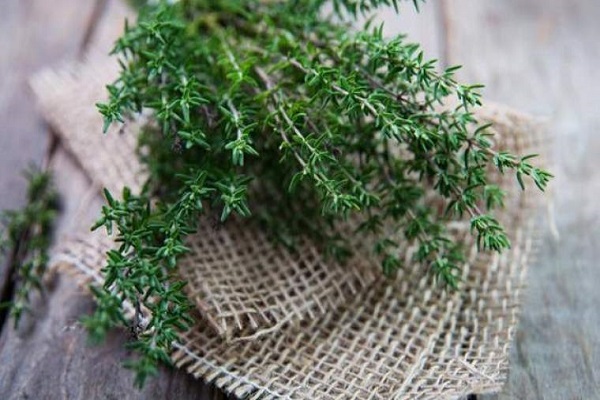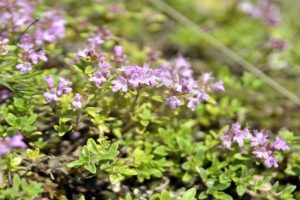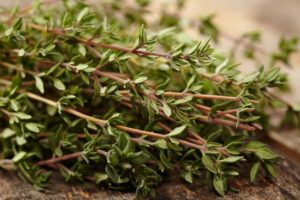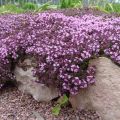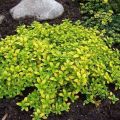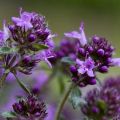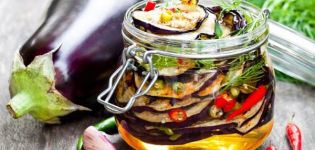Description of varieties and varieties of black thyme (thyme)
Black thyme is used by gardeners for landscaping. It is planted on alpine hills, small flower beds. It is in perfect harmony with the paths lined with decorative stone.
Content
- 1 Description of the plant
- 2 Thyme varieties
- 2.1 Purple violet
- 2.2 Mountain
- 2.3 Garden
- 2.4 Chalky
- 2.5 Rainbow
- 2.6 Pygmy
- 2.7 Bedbug
- 2.8 Bush
- 2.9 Altaic
- 2.10 Forest
- 2.11 Pretty
- 2.12 Sommertime
- 2.13 Perennial
- 2.14 Ural
- 2.15 Mossy
- 2.16 Crimean
- 2.17 Talieva
- 2.18 Early Minor
- 2.19 Red Carpet
- 2.20 Donne Valey
- 2.21 Ordinary Compactus
- 2.22 Creeping
- 2.23 Flea
- 2.24 Dorflera
- 2.25 Lemon (Archers Gold)
- 2.26 Subarctic
- 3 Choosing a suitable growing site
- 4 How to plant thyme
- 5 Reproduction methods
- 6 Features of plant care
- 7 Diseases and pests
- 8 Combination with other plants
- 9 Thyme on the windowsill
- 10 Pros and cons of using in landscaping
- 11 Where is thyme used
- 12 Thyme infusion recipe
- 13 The benefits and harms of the plant
- 14 Contraindications
Thyme blooms almost all season: flowering begins in May, ends in late August. But even without buds, the plant is very decorative. It is worth turning the curtain a little - the air will smell like resin. Plant phytoncides have a beneficial effect on the body.
Thyme has medicinal properties. It is successfully used by traditional medicine. Brewed herbal tea with a spoonful of honey will pleasantly warm the gardener on a winter evening.
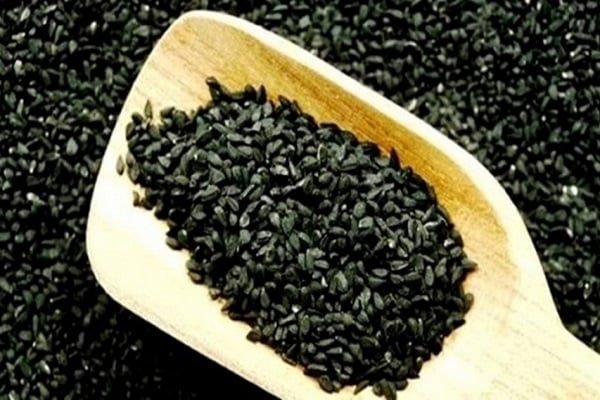
Description of the plant
Thyme represents the Lipo family. The thyme has a low stem: 20-40 cm. It is crowned with branches spreading on the ground. They resemble blueberry shoots. The plant also covers the soil with a solid carpet. Green twigs and stem are covered with fine hairs.
Elongated leaves are attached to the stem with short petioles. They have scent glands on them. They produce essential oil. The taste and smell of thyme is determined by the number of such glands.
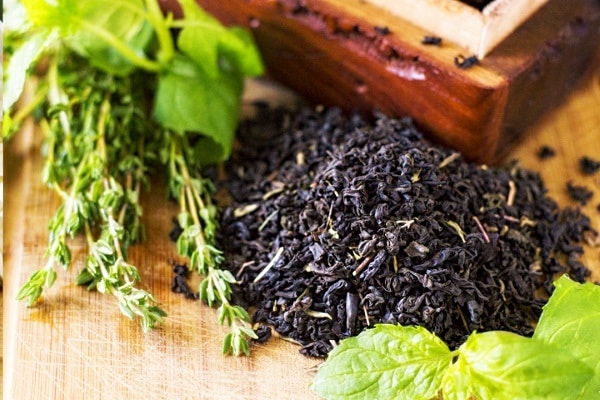
Flowers are collected in a bunch. They are white, lilac, purple, pink. Inflorescences are very compact, densely located on the branches. After flowering, fruits are formed - nuts. They have an elongated shape. Their length is 5-6 mm.
In the wild, an unpretentious plant is found on roadsides, mountain slopes, and sunny forest edges. It feels comfortable on the placer stones.
In the garden, thyme grows rapidly. It propagates by seeds and rooted shoots (vegetatively). If you do not limit the area, the thyme will cover all the ridges in the garden.
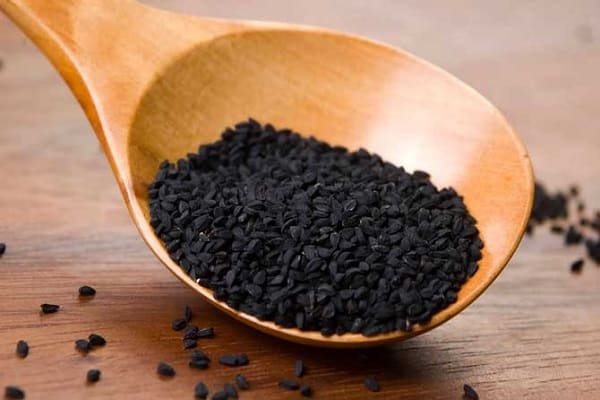
Thyme varieties
This plant is a member of the Lamb family. There are 400 known species of this unpretentious shrub. They differ in the size of the stems, their ascending or creeping position, the color of the corollas, and aroma.The most famous types of wild thyme are common and creeping.
Breeders are creating new varieties of thyme. Their stats have been improved relative to their wild counterpart. They are more decorative, their aroma is brighter. Gardeners have plenty to choose from. You can dig a bush in the wild and plant it in your garden. Or you can buy a cultivated plant.
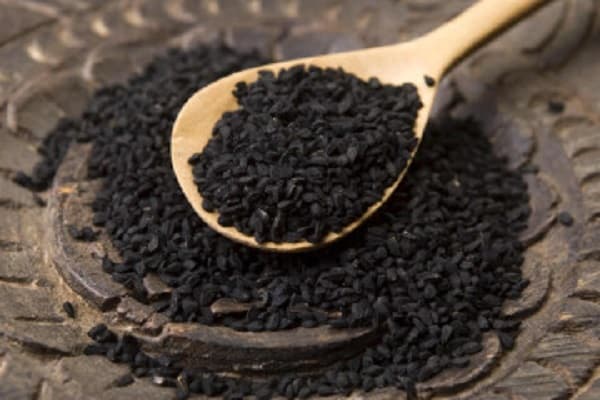
Purple violet
This shrub has short shoots (10 cm). The corollas of the flowers are colored with a bright purple-violet color. Covers the soil with a dense carpet. Aggressive towards other plants. Such shrubs should be planted in confined areas. Gardeners use sheets of steel, plastic, natural or artificial stone as a barrier.
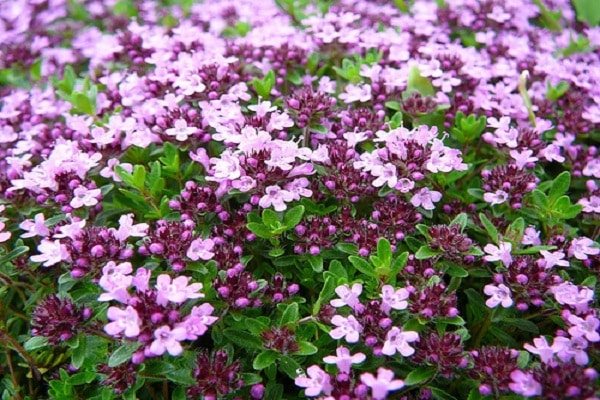
Mountain
This is what the people call flea thyme. This short plant has woody roots. They release low shoots (15 cm). The stems spread or rise slightly above the ground. The stem is found naked or covered with hairs, it is faceted or rounded. The leaves are also covered with hairs.
It blooms in soft pink or pink-red flowers. The air around him is saturated with ether. It settles in dry rocky areas. Does not tolerate excessive soil moisture.
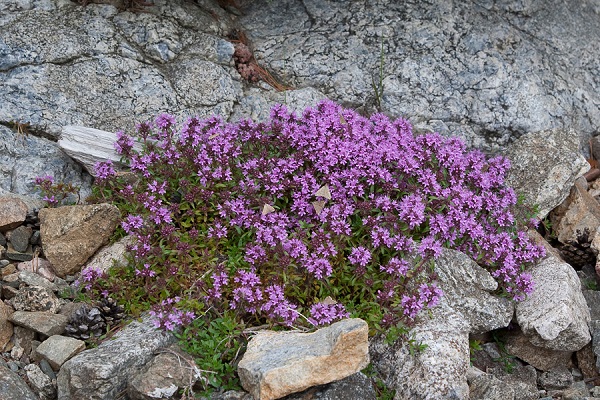
Garden
Gardeners choose varieties of Bogorodskaya grass in accordance with their own preferences and plant characteristics. For planting in the garden, the resistance of thyme to frost is taken into account. Do not plant heat-loving species in regions with cold winters.
When the area is flooded, moisture-resistant varieties should be chosen. For landing on an alpine slide, a flea or mountain slide is recommended.
Gardeners should consider the combination of the plant with other garden dwellers. The color and height of the cover should blend in harmoniously with the existing landscape.
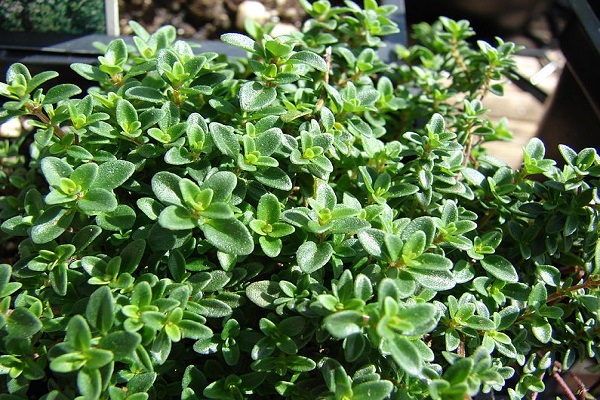
Chalky
Prefers chalk hillsides. Feels great in the place where limestone emerges to the surface. Drought-resistant.
Has short bare stems. They branch strongly. Shoots up to 12 cm long rise vertically upward. The flowers are invisible: the corolla is greenish, the petals are pink and purple. The plant is not decorative. But the aroma is strong. A wonderful honey plant. It should be placed near the beds with tomatoes, peppers, eggplants to attract pollinating insects..
A decrease in nutrients affects the condition of the shrub: it becomes less lush. But the flavor is getting stronger. Chalk thyme retains its dry odor even when stored carelessly.
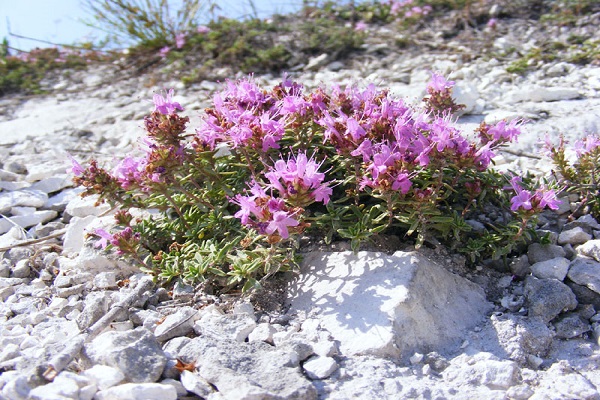
Rainbow
The second name is vegetable. Its value is fragrant juicy shoots. They are used for cooking.
The stem rises 25 cm above the soil surface. The leaves are green-gray, fragrant. It takes 30 days from germination to the first cut. Sensitive to soil moisture. When cultivated in cold regions, sun thyme requires shelter.
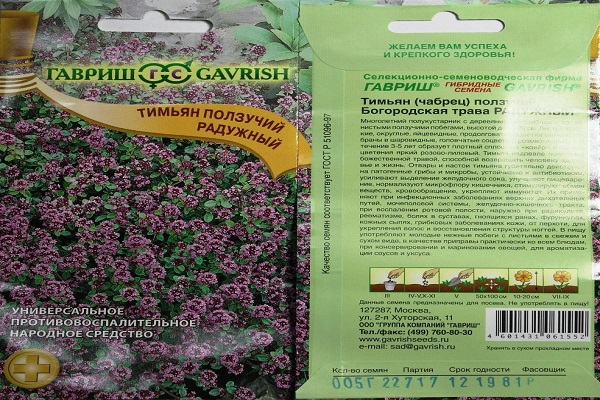
Pygmy
The smallest of the thyme. The trunk rises only 3 cm above the soil surface. It blooms in May-July with pale pink flowers. It does well without fertilization. But it needs regular watering. Decorative all season. Value: dense soil cover and preservation of a pleasant appearance during the entire warm period.

Bedbug
Semi-shrub up to 15 cm high. Shoots are creeping, easily rooting. It blooms with pink flowers from May to August.
It grows on stony chalk slopes, outcrops of the Carboniferous to the surface, on bare soils of pine forests. Sometimes it settles on sandy soils. Drought tolerant. Has value as a medicinal plant. The garden will be decorated with an alpine slide.
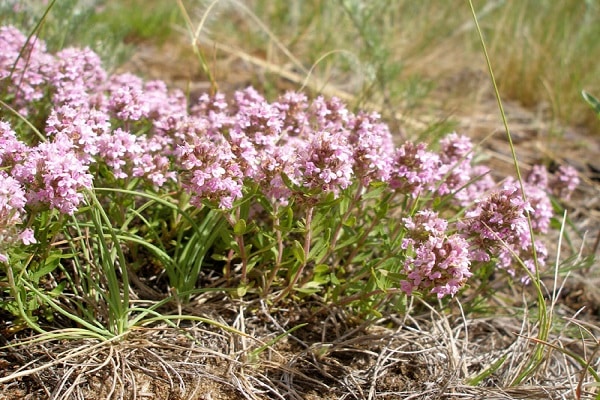
Bush
Gardeners will have to choose: plant bush or creeping thyme. The first one rises above the soil surface by 20-25 cm. It has looser clumps. Shrub thyme looks great as a track line or colored border.
Choose varieties that are suitable for the region. The soil for planting perennial shrubs must be prepared in a special way.
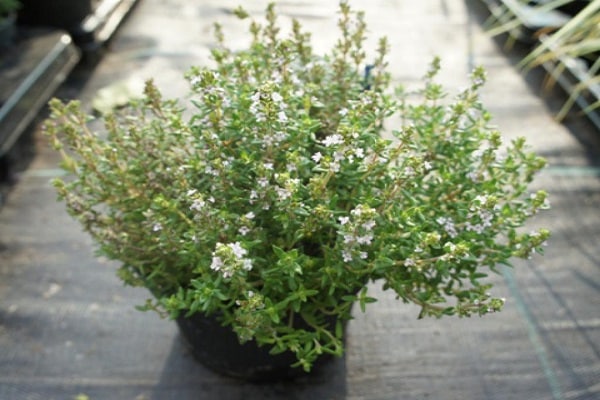
Altaic
A semi-shrub with highly branching shoots. Stem height 15-20 cm. It settles on rocks and mountain slopes. Selects chalky, gravelly and sandy soils. In June-August it blooms with purple flowers. Excellent honey plant. It grows in the valleys and foothills of Altai.
The value of the species: high content of essential oils, decorative, unpretentious... The plant will decorate the alpine slide in the garden, attract pollinators and provide the gardener with medicinal raw materials.
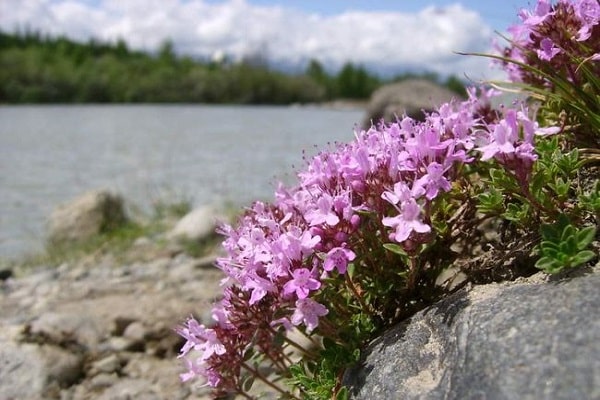
Forest
Thyme can also be found in the forest zone. He settles in well-lit meadows and forest edges. The semi-shrub chooses dry sandy or podzolic soils. It blooms with pink flowers from May to August. Stems grow up to 12 cm tall.
The value of the species: unpretentiousness, the ability to grow and bloom on dry poor soils.
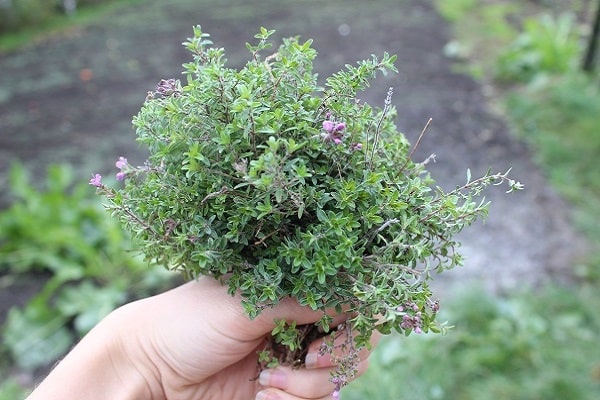
Pretty
Stem height - 30 cm. Shoots are long, creeping. The leaves are elongated. It blooms with large lilac flowers gathered in an ear. Prefers steppe areas open to the sun. Forms dense thickets. It is undemanding to soil and moisture. The value is decorative and unpretentious. Disappearing species. Gardeners can preserve the population by growing it on their site.
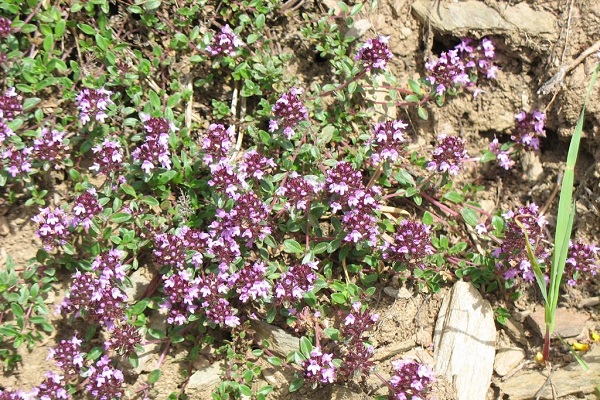
Sommertime
This variety differs in that strongly pubescent shoots do not lodge. They form a bright green ball with a diameter of 25 cm. Sommertime exudes a strong aroma. Gardeners grow it in pots to decorate the garden. Thyme winters at home.
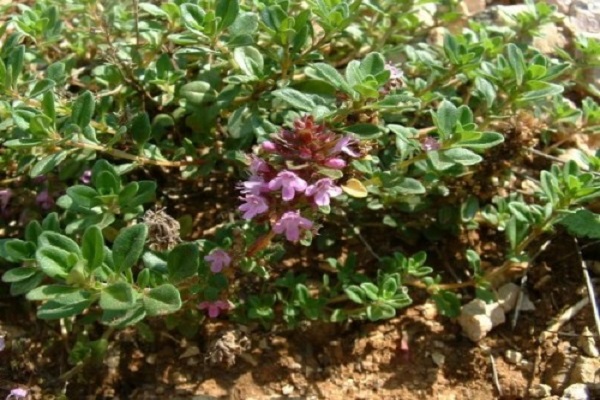
Perennial
Thyme is a perennial plant. Its stems and leaves are green in color. Flower corollas are lilac, pink, purple, even green. For successful cultivation in a summer cottage, you should carefully study the characteristics of the variety or species.
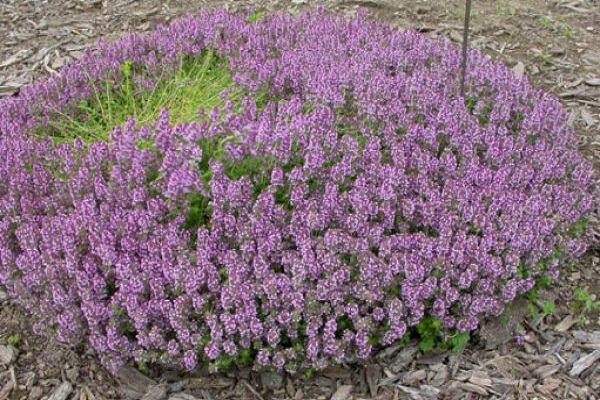
Ural
Thyme is found in the foothills of the Southern Urals. It grows on rocky, gravelly, chalk, sandy, black earth soils. Dislikes loam and clay. Characteristics:
- stress resistance;
- drought resistance;
- exactingness to good lighting.
Gardeners can decorate the site with an undemanding creeper with large pink flowers.
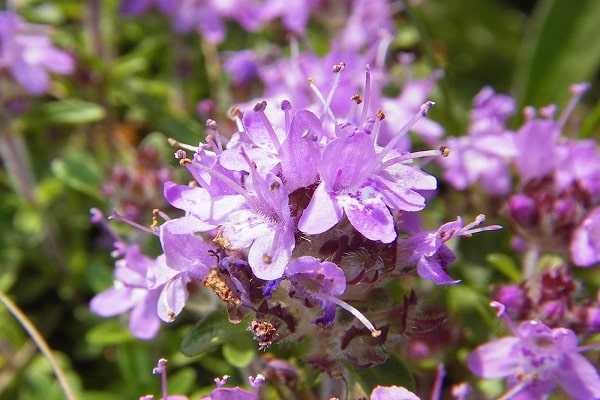
Mossy
Low Bogorodskaya grass. The stems of the shrub rise 1 cm above the soil. Leaves of a dark green hue are 3 mm long. There are no flowers. Forms a moss-like coating. Gardeners use thyme as an unpretentious aromatic substitute for moss.
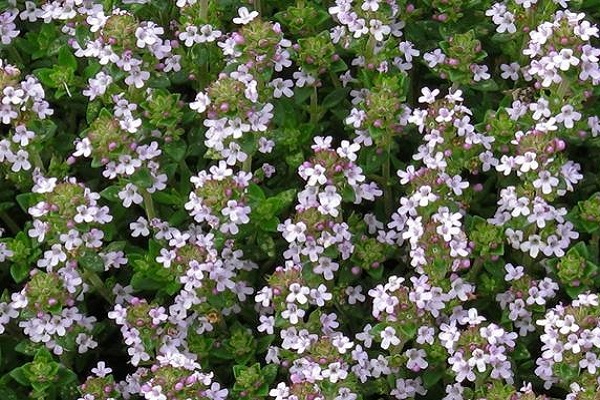
Crimean
The semi-shrub took a fancy to the Crimean Peninsula. Thyme grows on rocky and sandy soils in valleys and mountains. The height of the stems is up to 15 cm. The flowers have a violet-pink hue, open in June-July. Fruits are black nuts. Value: rich aroma, drought resistance.
Difficult to endure cold winters. With enough snow it winters well, with “black frosts” thyme freezes out. Gardeners in regions with cold winters should cover the plant.

Talieva
A semi-shrub with stems up to 12 cm high. Flowers are pink-purple. For growth, he chooses marls, stony taluses, limestone rubble. Begins to bloom in June. Nuts ripen at the end of August. It is found in the wild in North-Eastern Europe and the Urals.
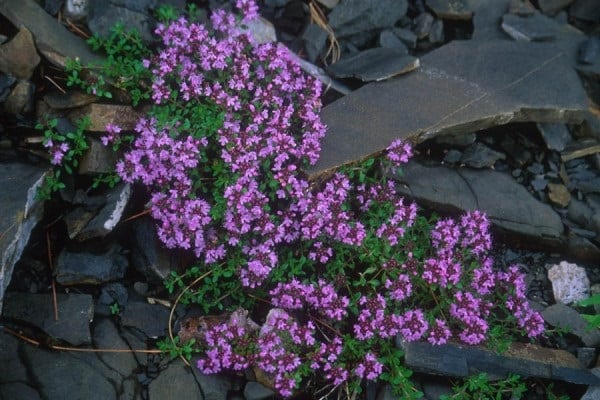
Early Minor
It grows slowly. The height of the stems of this variety of thyme is 5-10 cm. The pubescent leaves are small and exude a strong aroma. Blooms earlier than other varieties: in June. The leaves are colored lilac or light purple. Gardeners use it to decorate alpine slides.
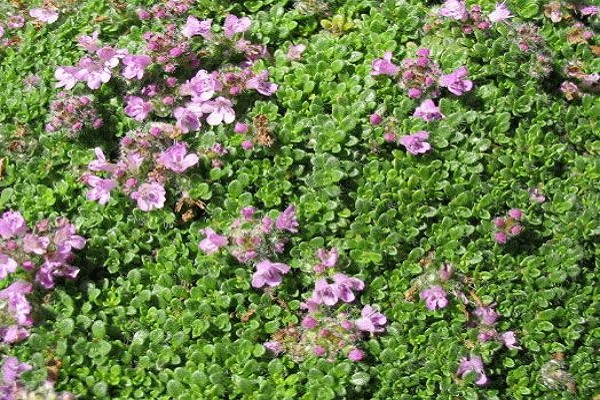
Red Carpet
The stems are 5 cm high. Red flowers bloom in June. Grows in full sun and partial shade. The variety prefers light fertile soils, but can also exist on poor stony soils. Created for garden decoration.
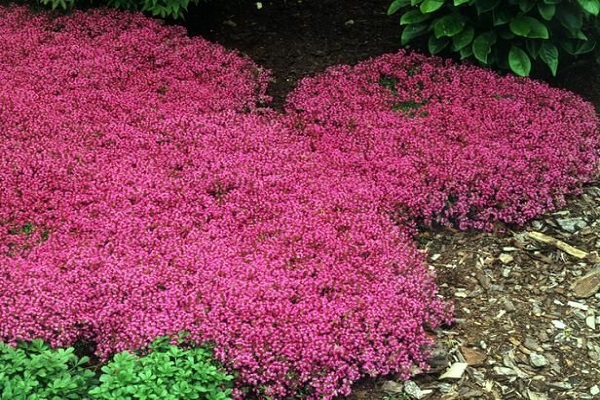
Donne Valey
The stems of this thyme variety rise up to a maximum of 30 cm above the soil. Shoots are decorated with small yellow-green leaves. A distinctive feature - the leaves smell like lemon.The inflorescence is capitate, loose. The flowers are light pink.
Forms dense curtains. Does not tolerate heavy soils and overflow. It can freeze in winter. It is appreciated by gardeners for its decorative effect and unusual aroma.
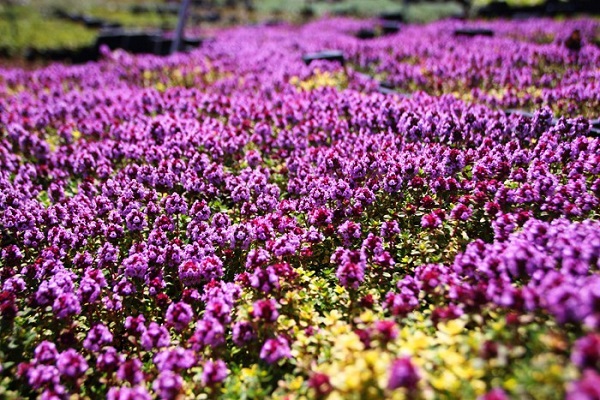
Ordinary Compactus
Compact shrub. The height of its stems does not exceed 15 cm. The shoots have a cylindrical profile. Downy underneath. The leaves are small, oval, lanceolate. Color - dark green. Delicate pink flowers have a purple tint. Blossom in July-August.
It works well on fertile light soils with good drainage. It is appreciated for its neat curtains.
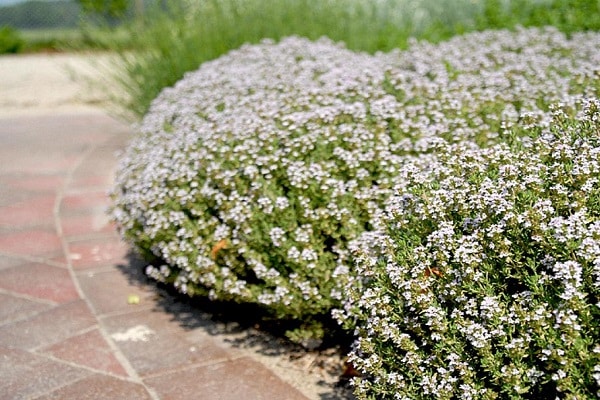
Creeping
A semi-shrub with creeping shoots. Thyme flowers are light purple in color. The inflorescence is an intermittent ear. Leaves are dark green, lanceolate. Downy underneath.
An excellent ground cover. It grows rapidly: during the season it is able to populate the entire plot (under favorable conditions). Used in alpine slides and for fragrant curbs. The value of the thyme species: unpretentiousness, availability of planting material.
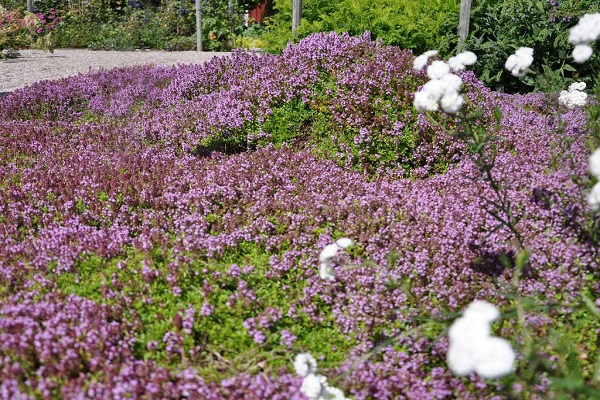
Flea
The second name is mountainous. Prefers stony, poor soils with good drainage. Drought tolerant. Does not tolerate waterlogging. The stems rise 15 cm. The flowers are red-pink or mauve. It is appreciated for its unpretentiousness and persistent aroma.
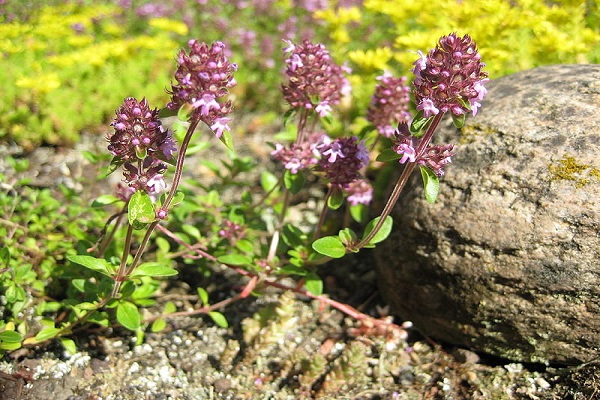
Dorflera
Aboriginal in the Balkan Mountains. Does not tolerate frost. It blooms with pinkish-gray flowers. The curved leaves are covered with frequent white hairs. Very decorative, but capricious.
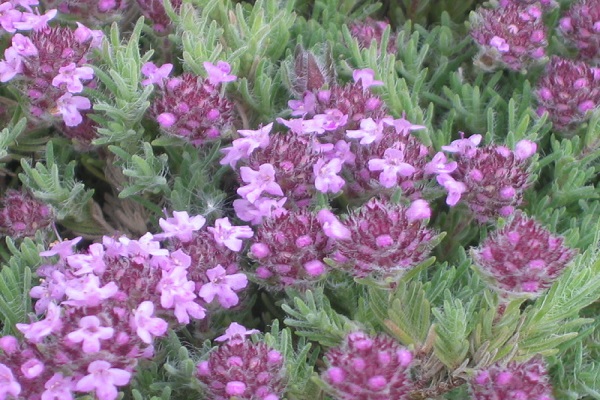
Lemon (Archers Gold)
This is an artificially created variety of thyme. Introduced into culture recently. The leaves have a characteristic green-golden color. Flowers are pale pink. During flowering, the plant presents itself as a solid pink carpet.
Sensitive to waterlogging. Fails on clays and loams. Used by summer residents on alpine slides. It is appreciated for its decorative effect, bright aroma and medicinal properties.
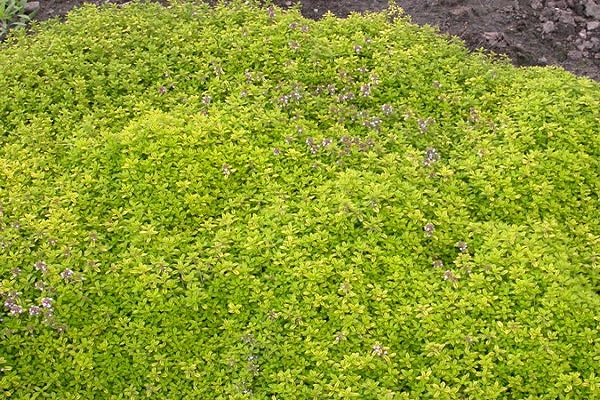
Subarctic
A semi-shrub with erect stems inhabits the forests of Eastern Europe. The type of thyme is easily recognized by its characteristic sharp carpet. Sod quickly. Drought-resistant and cold-resistant. Purple flowers are collected in capitate inflorescences. Stems and leaves are pubescent. It is prized for its high content of essential oils.
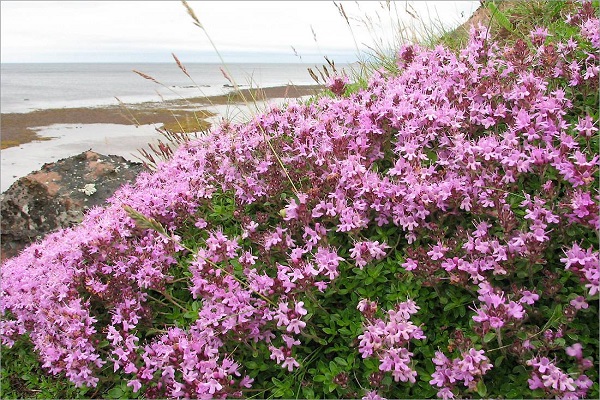
Choosing a suitable growing site
Thyme is an unpretentious plant. But in order to obtain a healthy, beautiful plant, the requirements of agricultural technology should be fulfilled:
- The landing site should be sunny or with light partial shade. When planted in the shade, the thyme stretches out. The shrub becomes loose, loses its decorative effect.
- Thyme varieties do not tolerate drafts. Shrubs should be planted in an area protected from northern and northeastern winds. It is not bad to locate the landings on the south side of the buildings.
- The landing site should not be flooded by melt or rainwater. It is advisable to arrange drainage.
- Prepare the soil in the chosen location. For this, it is recommended to study the characteristics of the plant and the conditions for its growth in the wild. Heavy soils (clay and loam) should be structured. It is required to add sand, chalk crushed stone (if necessary), mature compost.
- Particular attention should be paid to the acidity of the soil. For thyme, a neutral or slightly alkaline reaction is acceptable. On acidic soils, lime or ash should be added.
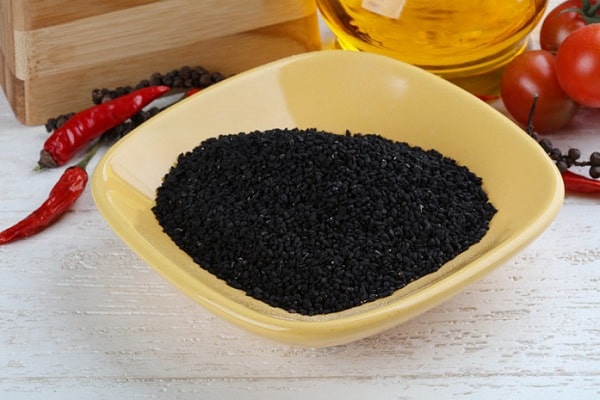
With proper placement, the shrub will delight the gardener with a dense fragrant curtain already in the year of planting.
How to plant thyme
Thyme is a cold-resistant plant. It can be planted immediately after the snow melts. When planting with a bush or rooted shoot, the plant should not be buried. After completing the work, the soil around it should be mulched. Stone chips, crushed stone, pebbles are suitable.
Thyme takes root in autumn plantings. The best time is early September. Shoots and bushes will have time to grow root systems necessary for wintering.This ensures the survival of the plant during the cold season.
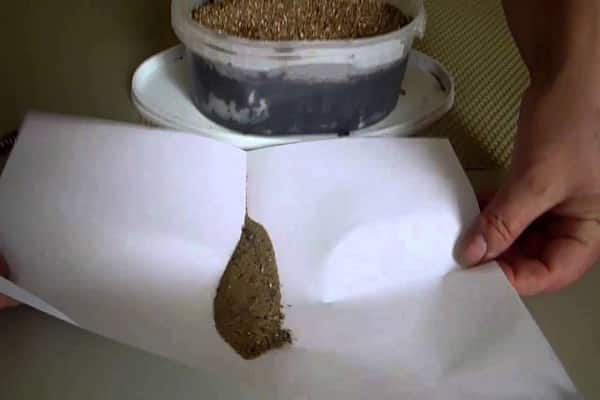
Reproduction methods
An unpretentious ground cover is easy to propagate by seed or vegetatively.
Seeds
This is a laborious way. To get a flowering plant in the first year, gardeners grow seedlings at home:
- In early February, seeds are sown in seed boxes to a depth of 0.5 cm.
- They are covered with a film with drainage holes for air access. Condensation is regularly removed from the film.
- Thyme seeds germinate in a warm place. Place the tray close to the heat source.
- After germination, the film is removed, the thyme bushes are thinned out. Leave the strong. Weak ones can be added to tea.
- When the soil dries, the thyme is sprayed. It is important not to overflow the soil: this will lead to decay of the roots.
- Thyme bushes are regularly tempered: the procedure will help them quickly take root in the garden.
- Thyme is planted in a permanent place after warming up the soil. 4-5 degrees is enough.
- The first 2-3 days thyme needs shading with lutrasil. It is impossible to overexpose the thyme in the shade: the shoots will stretch out.
The advantage of this method: obtaining a large amount of planting material.
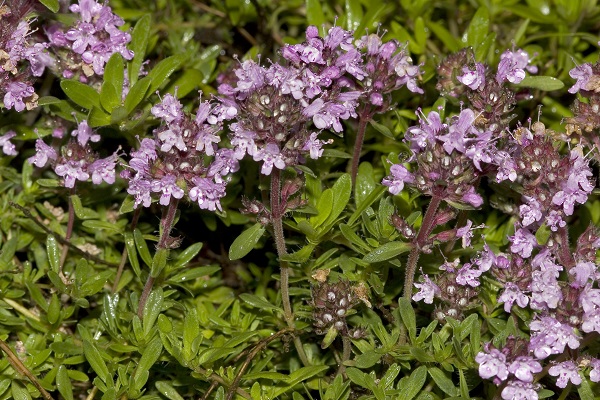
Cuttings
Thyme shoots take root easily. For reproduction, a non-lignified stalk is selected and a piece of the required length is cut off from it. In low-growing varieties, the stalk should have a maximum size of 5 cm.In tall varieties - 10-15 cm.
The stalk is immediately planted in a permanent place. A mini-greenhouse is being built over it. After 2-3 weeks, the gardener has a new plant.
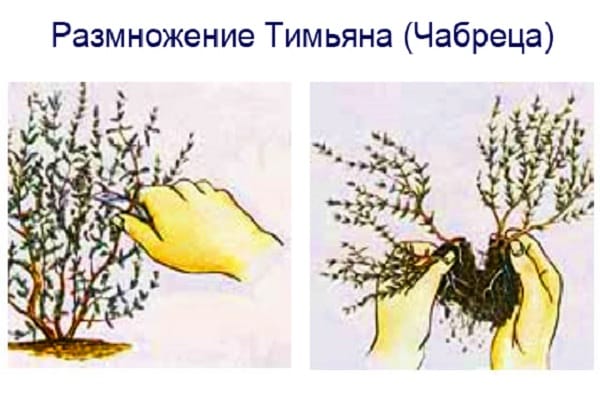
Sometimes the stalk of thyme is rooted in a greenhouse. The signal for root regrowth is the appearance of new green leaves.
Thyme shoots often take root on their own. The gardener only needs to cut off a branch with roots and transplant to a new place.
Advantages of the method: preservation of characteristics of hybrids and simplicity.
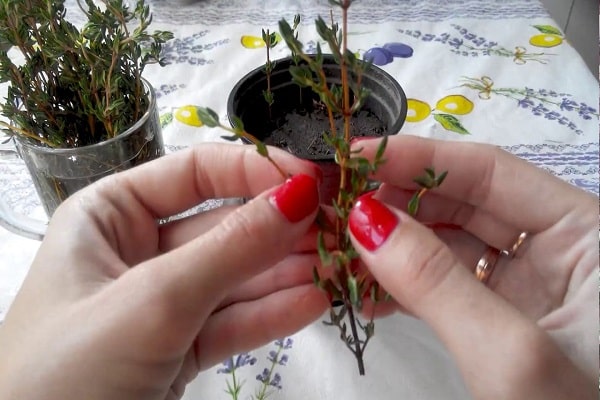
By dividing the bush
It is used when it is necessary to reconstruct an alpine slide or curb. The entire mother plant is dug up. Roots and shoots spread out. The bush is cut with a sharpened shovel or cut with garden shears. Places of incisions are powdered with crushed activated carbon. Delenki are transplanted to certain places.
Disadvantage of the method: the mother plant is injured. Skill and caution are required from the gardener.

Features of plant care
Thyme requires little maintenance. The gardener gets a beautiful plant with minimal labor costs.
Watering
A feature of the shrub is drought resistance. It should only be watered in severe drought. In this case, you should only slightly moisten the topsoil.
It is useful to spray the bushes before flowering. This will allow the plant to gain strength.
Overflow of thyme is very dangerous: the plant is easily affected by root rot and disappears. With prolonged heavy precipitation, the bushes should be covered with a film.
It is important to remember: thyme produces ether only in dry hot weather..
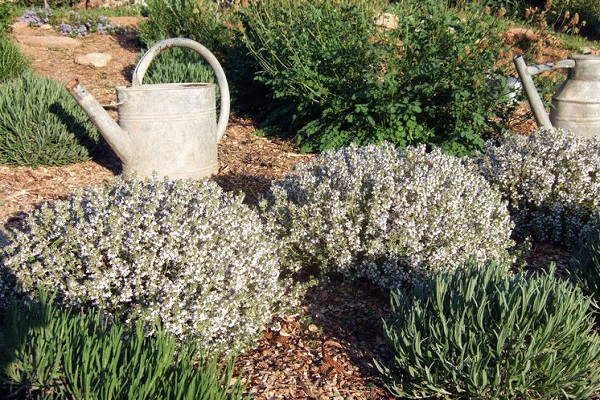
Light mode
Bushes are demanding on sunlight. In the shade, they wither, lose their compactness and decorativeness. Thyme shoots stretch out and turn pale. The curtain falls apart.
A beautiful and fragrant plant will delight the gardener when placed in a sunny place.
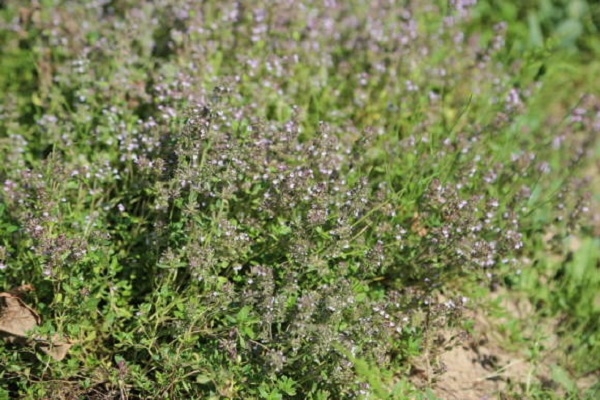
Top dressing
Thyme does not need special soil fertility. Most species in the wild grow on poor chalky or podzolic soils. Thyme varieties require a moderate amount of mature compost.
When growing thyme in the garden, sometimes lime or bone meal should be added. Fertilizing thyme with organic or mineral complexes is not required.
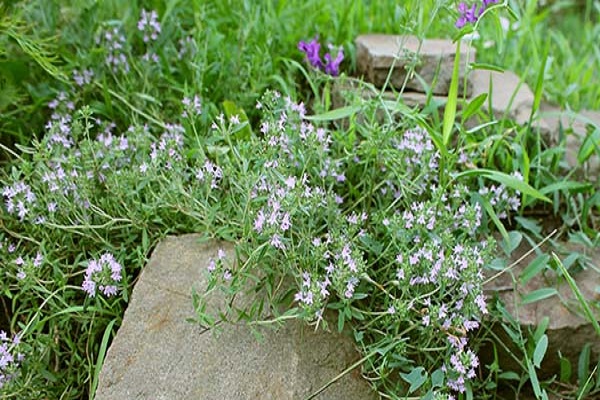
Weeding
Thyme does not tolerate shading. He needs bright sunlight. Weeds deprive him of a comfortable existence. They must be weeded out.
Drainage around the thyme with stone chips will eliminate the appearance of harmful plants. The introduction of chalk and constant loosening of the soil will help.
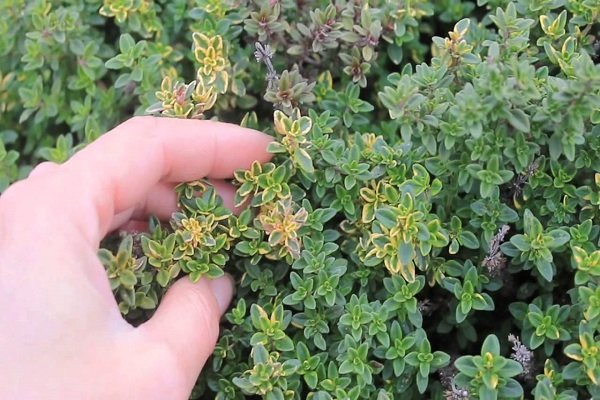
Pruning and shaping thyme
To obtain a dense coating and long flowering, thyme must be cut off. For this procedure, shoots with a small number of leaves are selected. Removing them provides the gardener with beautiful thyme throughout the summer.
Sometimes it is required to give the thyme a special shape. On the alpine slides, he must occupy a certain place. In this case, the thyme is cut at the request of the gardener using a topiary frame.
Often, gardeners carry out a healing pruning procedure after the thyme has faded. The thyme is mowed, leaving 2-3 cm above the ground. This event is a success in regions with warm winters. In cold areas, thyme can freeze out.
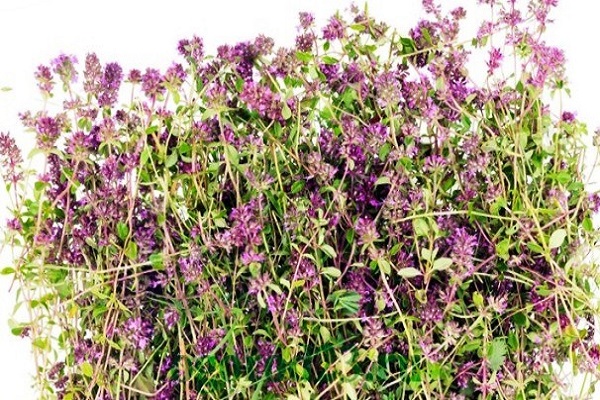
Diseases and pests
Subject to the rules of cultivation, thyme is resistant to diseases. In a rainy summer or with excessive watering, fungi attack the thyme. In this case, the entire bush is dug up, the soil is disinfected with a solution of copper sulfate.
Thyme is loved by aphids, weevils and sandy slugs. But they settle on weak shrubs. Healthy plants do not attract pests. Timely weeding and loosening serve as prevention. Compliance with the rules of cultivation is the main condition for the existence of beautiful thyme shrubs in the garden.
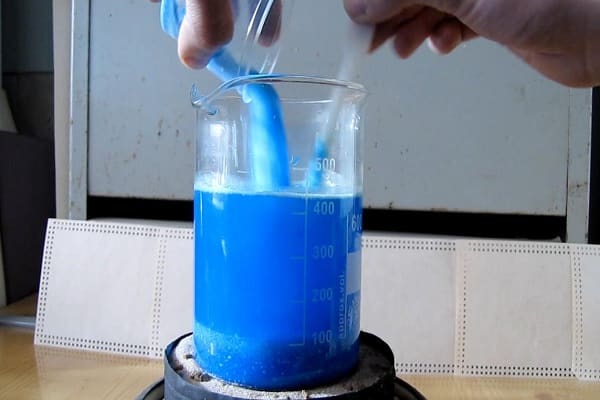
Combination with other plants
All varieties and types of thyme are perfectly combined with other plants. The ground cover has a shallow root system. This allows it to be grouped with deep-rooted plants.
Often, growers prefer to place thyme as a tapeworm. He is planted in hanging pots, filling a clearing in the recreation area. The ground cover looks lovely in these cases too.
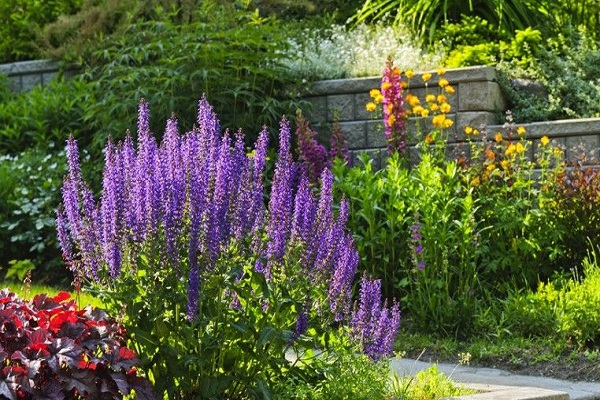
Gardeners are looking for interesting combinations of colors and aromas when forming plantings. Flowers are odorless, but with large bright petals complement the thyme ether.
Often gardeners will place thyme next to strong-scented flowers. They are filled with open ground. In this case, you should be very careful: mixing aromas can lead to negative consequences. The existing composition will have to be destroyed.
Thyme is a wonderful honey plant. It is specially planted next to vegetables requiring pollination. The presence of thyme ground cover in the garden increases the yield of cucumbers and tomatoes.
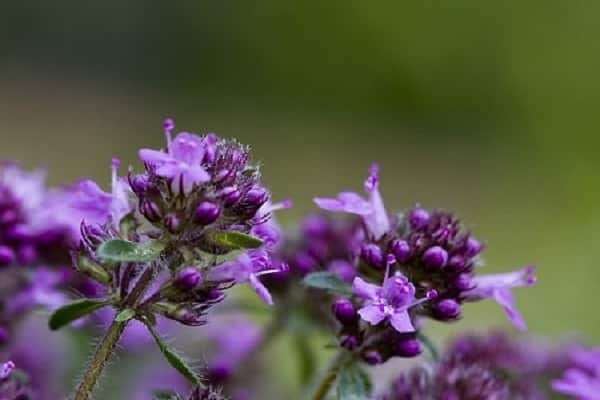
Thyme on the windowsill
The unpretentiousness of thyme allows you to grow it in an apartment. It is required to create comfortable conditions for thyme:
- pick up a container slightly larger than the roots of thyme (planting material is taken when dividing the bush);
- fill in the soil for succulents or cacti;
- add chalk crushed stone;
- mulch on top with stone chips;
- put on a sunny windowsill;
- protect from drafts.
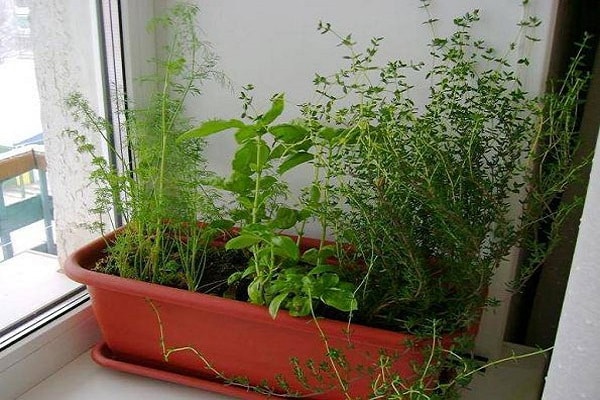
The advantage of thyme: it perfectly tolerates the dry winter air of rooms. Watering is required as the clod of earth dries out. On cloudy days, the thyme should be illuminated until 6 pm.
By placing thyme on the windowsillgardeners will be able to enjoy thyme ether throughout the year.
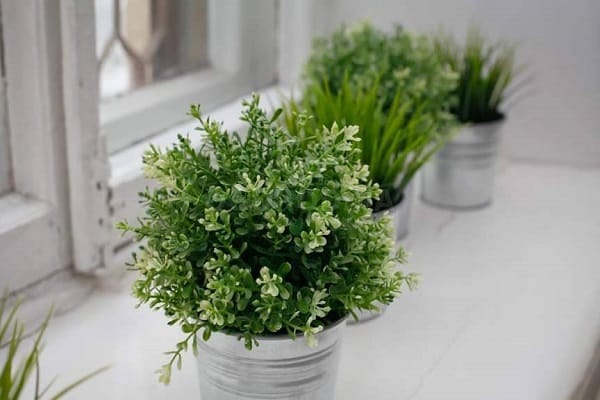
Pros and cons of using in landscaping
The presence of a dwarf shrub in the landscape will bring a lot of positive emotions to the gardener:
- The plant can serve as a background for large plantings or act as a tapeworm. There is no limit for imagination and creativity.
- The aroma of spice saturates the air with ether and makes it healthy. Walking in the garden, the summer resident receives an aromatherapy session.
- The honey plant revives the site: it attracts bright butterflies and bumblebees. The city dweller likes this kind of unity with nature.
- Beauty is not the only plus of the presence of thyme in the garden. The gardener can stock up on medicinal herbs for the winter.
- The shrub provides material for bouquets. Bogorodskaya grass goes well with mint, lovage and silvery wormwood. Popular belief attributes to this collection the ability to protect against evil spirits.
There is only one drawback of the presence of a dwarf shrub: rapid growth and aggressive seizure of territory. This problem is solved by mechanical limitation of landings.
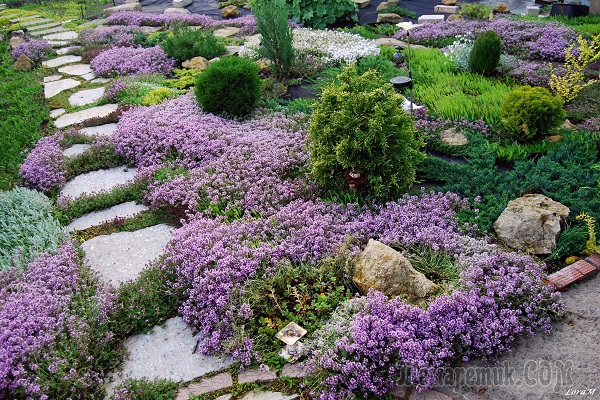
Where is thyme used
The shrub has an interesting chemical composition:
- acids (ursular, quinic, chlorogenic, coffee, oleanolic);
- fats;
- vitamins (C, A, PP);
- mineral salts;
- flavonoids;
- gum.
This makes it possible to use the leaves and stems for medicinal purposes. The oil obtained from thyme is used as a bactericidal and antiviral agent. The home medicine cabinet has many recipes for various ailments.
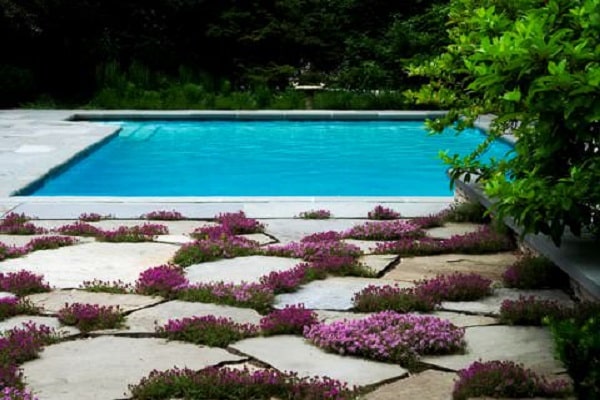
The plant is an excellent aphrodisiac. Thyme extract is a part of natural medicines to increase potency.
Essential oil is popular in scent treatments. The scent is used to relax and calm stressed people. It is dripped into the aroma lamp container. A candle lit at the bottom evaporates the water and vaporizes the air in the room.

An infusion or decoction is prescribed as a prophylactic or auxiliary agent for the treatment of diseases of the nervous system. Drinking drinks relieves irritation, improves sleep. Often canvas bags of dried thyme are hung indoors. The smell of a flowering meadow fills the room. The mood of the people in it rises.
Phytoncides contained in thyme heal the air. Disease-causing bacteria are killed. This property is useful for acute respiratory viral infections.
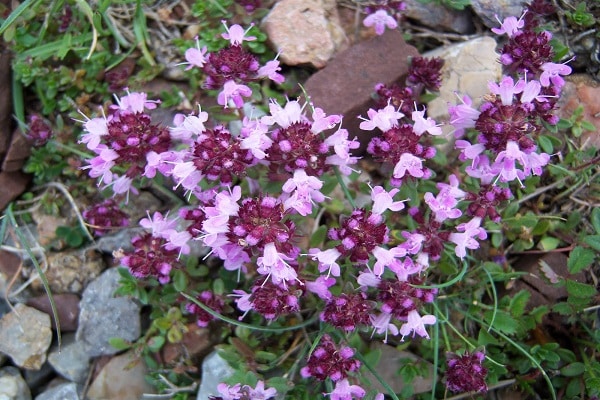
Thyme boosts immunity and strengthens the body. Resistance to colds, acute respiratory viral infections and flu increases. The infusion effectively treats a wet cough.
Shrubs and culinary specialists did not pass by. Mediterranean cuisine has many recipes that use spice leaves. Every gardener at least once tried black or green tea with thyme and bought spicy mixtures with this plant. Thyme extract often makes the composition of dishes original and unforgettable.
Cosmetologists use the bactericidal properties of the shrub to refresh inflamed, acne prone skin. Infusion baths soothe and nourish the skin with vitamins and minerals.
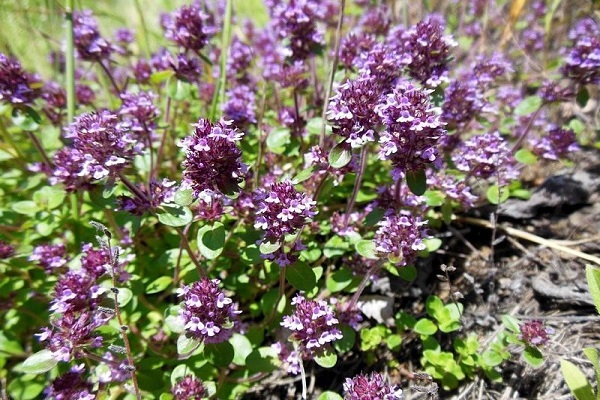
Thyme infusion recipe
Tincture in a water bath is used for rinsing the mouth and throat, inhalation, rinsing hair instead of purchased products. How to cook:
- chop equal parts of mint and thyme (dried or fresh);
- a tablespoon of the mixture is poured with a glass of water heated to 80 degrees;
- the dishes are wrapped and insisted for an hour in a warm place;
- the ready-made infusion after straining is divided into 4 equal parts.
Take the remedy regardless of food. For flavor, it can be diluted with water and sweetened with honey.
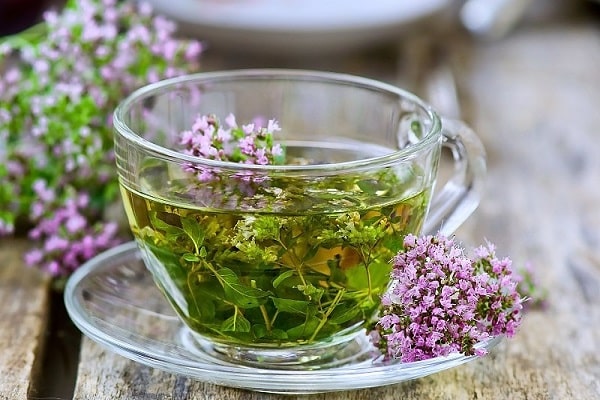
A decoction of thyme is prepared as follows. Dry or fresh grass should be crushed (plant fractions will give all the elements more fully). Pour 1 liter of cold water and bring to a boil in a water bath. Wrap, cool, drain. The broth is taken in equal parts throughout the day.
Thyme alcohol tincture
This product is recommended to be taken internally and used instead of lotion for problem skin. How to cook:
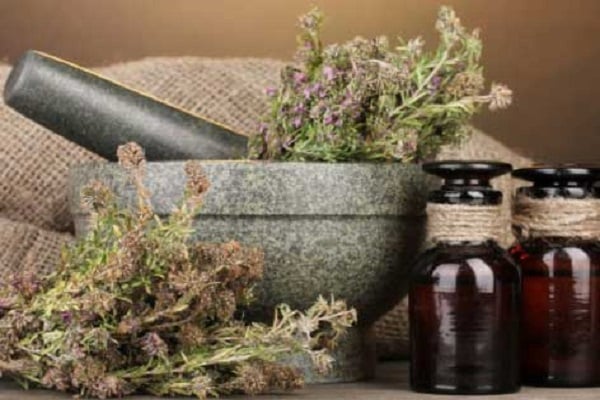
- chop a glass of fresh thyme shoots;
- put in a glass jar with a tight-fitting lid;
- pour 0.5 liters of good vodka;
- keep in a cool dark place for 3 weeks;
- shake once every 7 days.
Strain the infusion and store in the refrigerator. Take half a teaspoon orally once a day. To cleanse the skin, wipe your face with a cotton pad moistened with tincture. It is recommended to add the product to the water when rinsing hair (a teaspoon per liter of warm water).
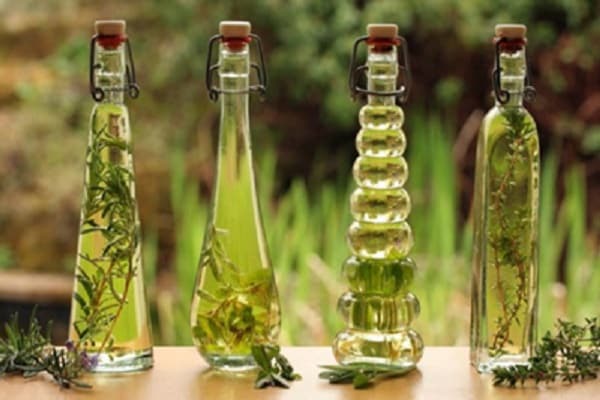
Benefits of the product: alcoholic extract of thyme is stored for a long time (up to 1 year), prepared in June (the herb is gaining maximum useful properties). Disadvantage: Not everyone is allowed to take alcohol.
The benefits and harms of the plant
There are no absolutely useful or harmful plants in nature.Before using the drugs, you should familiarize yourself with the properties and contraindications. If necessary, you should visit a doctor before treatment.
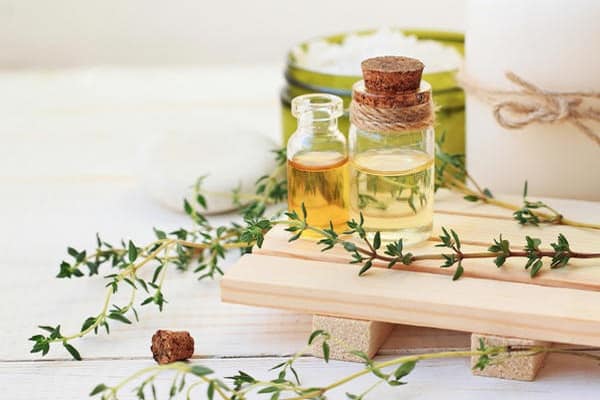
Thyme has a strong effect on the body:
- The shrub has anti-inflammatory, analgesic properties. Infusions are used for toothache as an oral rinse. Decoctions help reduce inflammation in sore throat or stomatitis.
- Thyme helps to normalize blood circulation.
- Traditional medicine recommends using a decoction or oil as a disinfectant for minor cuts and skin injuries. This is especially useful for gardeners working with the land.
- The oil promotes healing of wounds and cracks. Children will love this aromatic medicine. Every gardener should have it in his first aid kit.
- Herbal tea strengthens the immune system. It will help improve the condition, helps with furunculosis, diabetes. But you need to visit a doctor to prescribe a treatment regimen.
The beneficial properties of the aromatic herb are used in preparations for the treatment of colds and flu. Thyme vitamin tea is useful for spring vitamin deficiency.
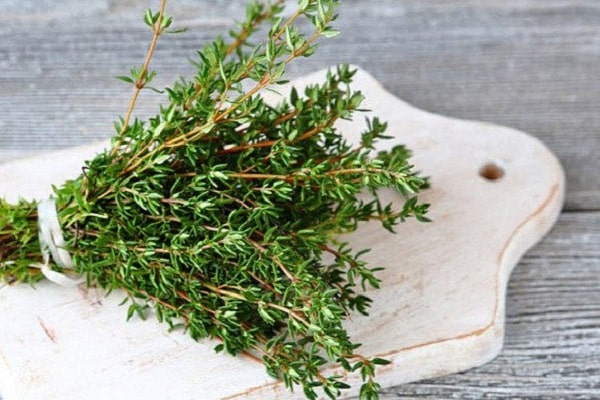
Contraindications
Not everyone is allowed to use thyme preparations without harm to health. You should limit the use of drugs and teas:
- pregnant and lactating women;
- patients with liver and kidney disease;
- suffering from gastric and duodenal ulcers;
- allergy sufferers;
- people with high blood pressure.
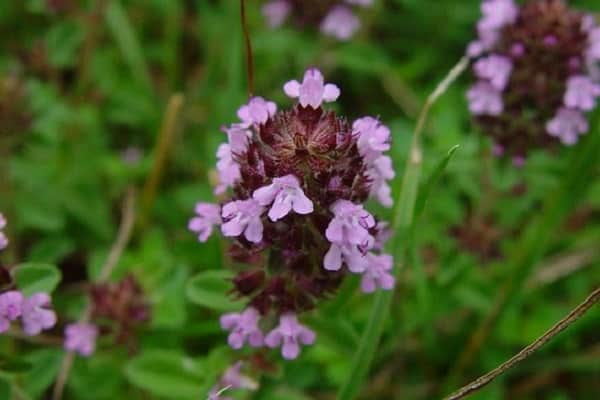
Thyme will not be useful for people with individual intolerance to its components. Thyme has the ability to warm. Its use as an antipyretic agent will lead to undesirable consequences. The patient's condition will worsen.
It is important to remember: long-term use of medications will provoke nausea and vomiting. The use of funds should be stopped and a doctor should be consulted.
